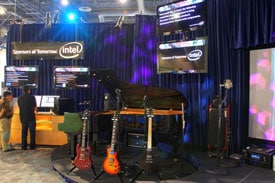Waskul Entertainment Uses Yamaha Disklavier in 2010 NAB Show Exhibit

The Disklavier was prominently placed on an oval stage within the Intel exhibit and was featured in multiple settings: a recording studio, a television/broadcast studio and a live performance venue. Photographer's Credit: Adam Glick |
The Disklavier was prominently placed on an oval stage within the Intel exhibit and was featured in multiple settings: a recording studio, a television/broadcast studio and a live performance venue. Acclaimed pianist and vocalist Sarah Thiele played the Yamaha Disklavier during three live concert performances. Waskul also staged a master audio recording session and used the Disklavier to show participants how to properly mic and record with a live piano. During the latter exhibition, the Disklavier was playing previously recorded music.
"We are happy to have met Steve Waskul, and are excited about the possibilities that could take place as a result of the synergies between Yamaha and Intel," says Jim Levesque, Disklavier Marketing Manager, Yamaha Corporation of America.
Waskul selected the Yamaha Disklavier because he determined it would be just the right piano to create a unique and interesting application for SSD technology. "For our NAB demonstrations, I wanted all of the components to 'make sense' to the engineers who would be attending our theater presentations. As the most popular piano in recording studios, the Yamaha C7 was the logical choice," says Waskul. "As I investigated further though, and learned about the capabilities of the Yamaha's Disklavier system for both a studio and home environment, it became clear that this instrument was exactly what we needed. The Yamaha Disklavier DC7 not only made the demonstrations relevant to our NAB audience; it took things a step above by allowing us to integrate Intel's solid state technology as well."
For the demonstration, Waskul modified the Disklavier's normal recording and playback functions by replacing a traditional hard disk drive (HDD) with an Intel SSD with 160 gigabytes (GB) of flash memory. The Intel SSD not only provided a performance boost over the HDD, but doubled the storage capacity for recorded music as well as reduced heat- and noise-generation. Unlike mechanical hard drives, the SSDs contain no moving parts thus enabling a noise-free environment for improved acoustics critical to studio recording and television/video production and an enhanced listening experience. SSDs also do not generate as much heat as hard drives, so the SSD helps better protect the wood soundboard located near the recording unit.
The exhibit marked the first time an acoustic piano was powered by an SSD, and Waskul also believes the Disklavier may have been the only piano at the NAB Show. "The Yamaha Disklavier played a key role in the success of our NAB demonstrations. It was the perfect choice for our recording studio/television studio/live performance environment centered around Intel-based hardware and software solutions. With the addition of the Intel SSD, we took the instrument to a new level and demonstrated a very unique application of Intel technology that made our audiences think beyond the traditional applications for these devices. I am always looking for unique and interesting applications to showcase my client's technology, and the Disklavier definitely helped to achieve that. Many people commented on how they would like to have the system in their homes and how fabulous the piano sounded," Waskul adds. "From Sarah Thiele to the piano tuners to the attendees who played piano, everyone agreed the system was a winner!"
This year, more than 85,000 participants from more than 157 countries attended the 2010 NAB show.
For more information on the Disklavier, write Yamaha Corporation of America, Keyboard Division, P.O. Box 6600, Buena Park, CA 90622; telephone (714) 522-9011; e-mail infostation@yamaha.com; or visit www.yamaha.com/disklavier.
